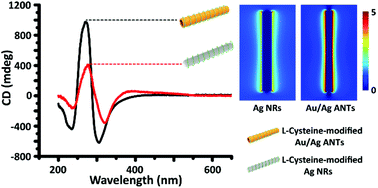Chiroptical study of the bimetal–cysteine hybrid composite: interaction between cysteine and Au/Ag alloyed nanotubes†
Abstract
The coupling between noble metal nanostructures and chiral molecules gives rise to strong chiroptical responses in the range from the ultraviolet (UV) to visible spectrum. In this work, cysteine-modified Au/Ag alloyed nanotubes (ANTs) have been prepared by coupling cysteine with Au/Ag ANTs. The chiroptical responses strongly depend on the chirality of cysteine and show clear mirrored behaviours. In contrast to Ag- or Au-cysteine chiral hybrid nanorods, the cysteine-modified Au/Ag ANTs exhibit higher chiroptical responses due to a stronger local electromagnetic field. The induced CD signals emerge in the interband absorption region of Au/Ag ANTs rather than in the local surface plasmon bands, which can be attributed to both the extended helical network conformation on the surface of Au/Ag ANTs and the near-field enhancement effect of plasmonic nanotubes. This confirms that Coulomb interaction induces coupling between cysteine and Au/Ag ANTs, which allows cysteine molecules to form an extended helical network on the surface of Au/Ag ANTs. Furthermore, the cysteine-modified Au/Ag ANTs also show excellent chiral recognition for amino acids in catalytic electrochemical reactions due to the presence of chiral active sites and the steric effect of large groups.



 Please wait while we load your content...
Please wait while we load your content...